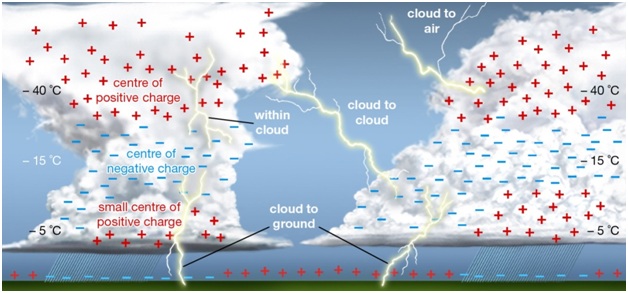Increasing lightning strikes with climate change
According to the Earth Networks India Lightning Report, 2019, lightning kills more people than cyclones in India and it could increase as much as 12% with every 1-degree increase in global warming.
Context
According to the Earth Networks India Lightning Report, 2019, lightning kills more people than cyclones in India and it could increase as much as 12% with every 1-degree increase in global warming.
- India sees 2,000-2,500 lightning deaths every year on average. Lightning is the biggest contributor to accidental deaths due to natural causes.
What are Lightning strikes?
- Lightning is a very rapid and massive discharge of electricity in the atmosphere, some of which is directed towards the Earth’s surface.
- These discharges are generated in giant moisture-bearing clouds that are 10-12 km tall.
- Base: The base of these clouds typically lies within 1-2 km of the Earth’s surface, while their top is 12-13 km away.
- Temperature: Temperatures towards the top of these clouds are in the range of minus 35 to minus 45 degrees Celsius.
The process
- Heating: As water vapour moves upward in the cloud, the falling temperature causes it to condense. Heat is generated in the process, which pushes the molecules of water further up.
- Formation of ice crystals: As they move to temperatures below zero degrees celsius, the water droplets change into small ice crystals.
- Fall: They continue to move up, gathering mass until they are so heavy that they start to fall to Earth. This leads to a system in which, simultaneously, smaller ice crystals are moving up and bigger crystals are coming down.
- Release of electrons: Collisions follow and trigger the release of electrons. As the moving free electrons cause more collisions and more electrons, a chain reaction ensues.
- Positive, negative charge: This process results in a situation in which the top layer of the cloud gets positively charged, while the middle layer is negatively charged.
- Flow of massive current: The electrical potential difference between the two layers is huge of the order of a billion to 10 billion volts. In very little time, a massive current, of the order of 100,000 to a million amperes, starts to flow between the layers.
- Heating of air column: An enormous amount of heat is produced, and this leads to the heating of the air column between the two layers of the cloud.
- This heat gives the air column a reddish appearance during lightning.
- Thunder: As the heated air column expands, it produces shock waves that result in thunder.

How does this current reach the Earth from the cloud?
- Earth is a good conductor of electricity and is electrically neutral.
- However, in comparison to the middle layer of the cloud, it becomes positively charged.
- As a result, about 15%-20% of the current gets directed towards the Earth as well.
- It is this flow of current that results in damage to life and property on Earth.
Why taller objects are more at risk?
- There is a greater probability of lightning striking tall objects such as trees, towers or buildings.
- Once it is about 80-100 m from the surface, lightning tends to change course towards these taller objects.
- This happens because air is a poor conductor of electricity, and electrons that are travelling through air seek both a better conductor and the shortest route to the relatively positively charged Earth’s

